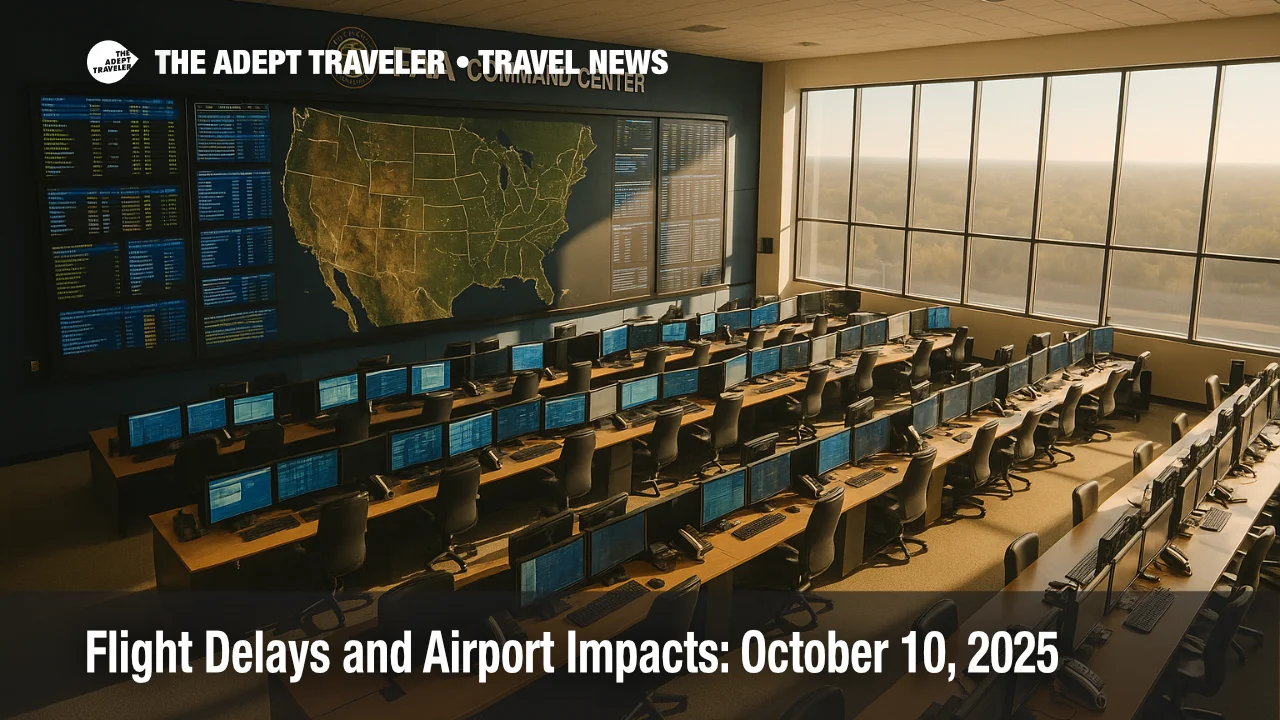Flight delays and airport impacts: October 10, 2025

The FAA's morning operations plan points to a mixed day for travelers, with thunderstorms across Florida and the desert Southwest, low ceilings in San Francisco, and construction constraints at several major hubs. Planners list potential afternoon ground stops or ground delay programs at Boston, Miami, Fort Lauderdale, Seattle, Denver, and Las Vegas. A published routing to Orlando is active early to manage inbound volume, and en-route thunderstorm risks could trigger reroutes later in the day.
Key points
- Why it matters: Afternoon programs could stack delays at multiple hubs, stressing connections.
- Travel impact: Boston, Miami-Fort Lauderdale, Seattle, Denver, Las Vegas carry program risk after mid-afternoon.
- What's next: Florida and Southwest storms may prompt CDRs, SWAP, or escape routes into the evening.
- Low ceilings in San Francisco can reduce arrival rates and ripple across transcon schedules.
- Construction at O'Hare, Tampa, Indianapolis, Phoenix, Houston Intercontinental, Orlando, San Francisco, Boston, and San Diego adds friction.
Snapshot
As of the first planning cycle, the FAA does not anticipate morning initiatives at the New York terminals beyond local demand management, with Boston Logan International Airport (BOS) the early outlier. In Florida, thunderstorms around Jacksonville and Miami centers could slow arrivals into Miami International Airport (MIA), Fort Lauderdale-Hollywood International Airport (FLL), and Orlando International Airport (MCO), where a Northeast-to-Orlando route is active to help meter traffic. To the west, San Francisco International Airport (SFO) sits under low ceilings, and Harry Reid International Airport (LAS) is on watch for convective impacts. Program risk grows after 300 p.m. to 400 p.m. Eastern for Boston, Miami-Fort Lauderdale, and Seattle-Tacoma International Airport (SEA), with Denver International Airport (DEN) and Las Vegas possible after 8:00 p.m. Eastern.
Background
The operations plan is updated after each FAA planning webinar and sketches where ground delay programs, ground stops, and en-route tools are likely. Today's plan highlights both weather and infrastructure factors. Thunderstorms threaten airspace managed by Miami, Albuquerque, Los Angeles, Denver, and Salt Lake City centers, while Washington Center has a published NRP suspension that can affect flight planning. Construction limits at Chicago O'Hare International Airport (ORD), Tampa International Airport (TPA), Indianapolis International Airport (IND), Phoenix Sky Harbor International Airport (PHX), George Bush Intercontinental Airport (IAH), MCO, SFO, BOS, and San Diego International Airport (SAN) may constrain runway use or taxi flows. For broader context on rolling delay programs during the federal funding lapse, see our recent coverage, including FAA staffing and shutdown: Rolling delay programs likely.
Latest developments
Afternoon ground program risk expands at coastal and mountain hubs
The FAA lists BOS as "expected" for a ground stop or delay program after 400 p.m. Eastern, with MIA and FLL "possible" after 300 p.m. Eastern. SEA shows "possible" after 400 p.m. Eastern, while DEN and LAS become "possible" after 800 p.m. Eastern. Low ceilings continue to pressure SFO's arrival rate. Early in the day, a Northeast-to-MCO route helps meter Orlando arrivals, and planners warn of potential CDRs, SWAP, arrival routes, and escape routes through the late afternoon and evening over Phoenix, Las Vegas, and Florida corridors. Oceanic and Atlantic Y-route closures are "probable" into the overnight, which can lengthen flight times on transatlantic and coastal flows. If you are connecting through these nodes, pad your itinerary and monitor airline alerts.
En-route weather and construction could prolong delays into the evening
Thunderstorm risk spans airspace within Miami (ZMA), Albuquerque (ZAB), Los Angeles (ZLA), Denver (ZDV), and Salt Lake City (ZLC) centers, raising the odds of altitude caps, tunneling, or time-based metering. Washington Center's NRP suspension through October 31 reduces some flight-planning flexibility on longer domestic legs. Ongoing projects include SFO taxiway Z rehabilitation through November 14, BOS runway 09/27 closure through November 15, and runway closures or work zones at ORD, TPA, IND, PHX, IAH, and MCO. These constraints can magnify even modest weather, especially during banked peaks. For airport-specific ripple effects from yesterday's staffing-strained periods at Newark, see Newark flight delays during the shutdown.
Analysis
Today's pattern reflects a familiar shoulder-season squeeze: marine stratus in Northern California, scattered convection in Florida, and late-day buildups over the Basin and Range. When multiple hubs carry "possible" programs in the same window, the network's ability to recover slack diminishes. BOS's "expected" program after 4:00 p.m. Eastern could intersect with Florida reroutes and Southwest CDRs, pushing average delays beyond the advertised meter times and increasing misconnect risk on evening banks. If SEA joins the list, transcontinental and transpacific itineraries may face longer taxi-out times or holds due to metering and configuration constraints. Construction at BOS and SFO, plus runway and taxi limitations at ORD, PHX, IAH, and MCO, add friction that blunts recovery. Travelers can lower stress by selecting earlier flights, building 90-minute buffers on domestic connections and two hours on international, and favoring nonstop options where possible. Watch for carriers to issue weather waivers in Florida and the Northeast if convective coverage expands.
Final thoughts
Plan for rolling delays after mid-afternoon at Boston, Miami-Fort Lauderdale, Seattle, Denver, and Las Vegas, with low ceilings likely to keep San Francisco tight. Add buffer time, enable flight alerts, and consider earlier departures to outrun the worst weather. We will continue to track reroutes and initiatives that drive flight delays across the network.
